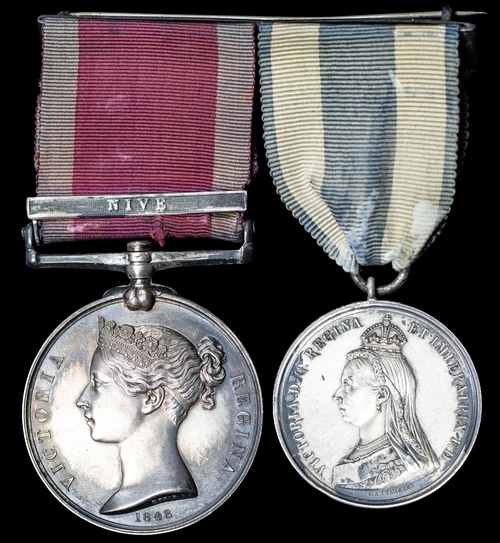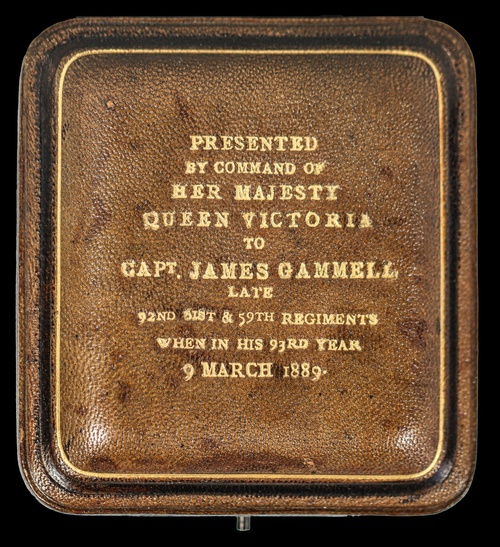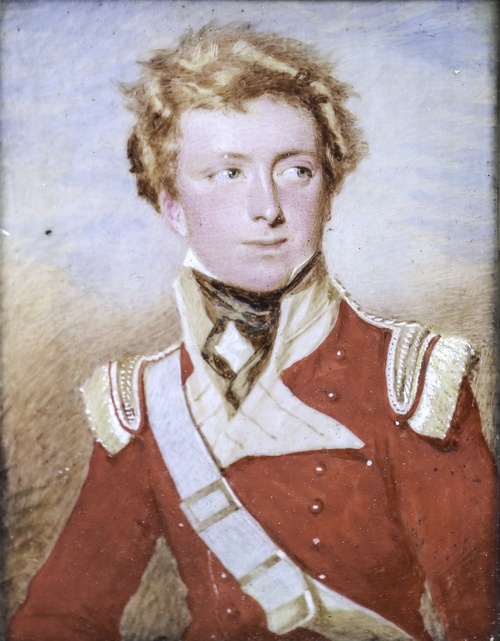Auction: 25001 - Orders, Decorations and Medals
Lot: 104
Sold by Order of a Direct Descendant
'After some delay...a letter was received on Tuesday from Sir George explaining that the claim of the old Peninsular veteran had been doubly recognised; with the sanction of H.R.H, the Queen has been informed through Sir Henry Ponsonby of Captain Gammell's case, and Her Majesty was so interested in it that she decided to present to the veteran her Jubilee medal, in addition to the Peninsular medal...Those who know what a staunch supporter of the Throne and Constitution he has always been, as well as a brave officer in his younger days, will heartily congratulate him on the double honours he has received, especially his kind recognition by the Queen' (Bath Chronicle & Weekly Gazette, Thursday 28 September 1893, refers)
The historically fascinating and unique Peninsular War and Queen Victoria Jubilee pair awarded to Captain J. Gammell, late 59th, 92nd and 61st regiments of Foot, who was almost certainly the last surviving British Officer of the Peninsular War and who claimed his campaign Medal in 1889 - an astonishing 75 years after the battle in which he participated and such a remarkable circumstance that The Queen herself then commanded that he should also be awarded her Jubilee Medal
Military General Service 1793-1814, 1 clasp, Nive (Ensign, James Gammell. 59th Foot.), this officially named in the style of the Egypt and Sudan Medal 1882-89; Jubilee 1887, silver, unnamed as issued, mounted together upon a silver bar for wear, on their original ribands and contained within a bespoke fitted leather case by Mallett, Goldsmith, Bath, the top lid tooled in gilded letters stating: Presented by Command of Her Majesty Queen Victoria to Capt. James Gammell, late 92nd, 61st and 59th Regiments, when in his 93rd year, 9 March 1889., traces of old lacquer, otherwise about extremely fine (2)
James Gammell, second son of Lieutenant-General Andrew Gammell and Martha Stageldoir, was born in London on 3 January 1797. Scion of an old Scottish family, his father enjoyed a long (if undistinguished) military career and appears to have been a personal friend of H.R.H. the Duke of York; it is he who may have been responsible for the elder Gammell's appointment to the socially-prestigious 1st Foot Guards in September 1803.
On 29 September 1813, young James Gammell was commissioned Ensign (without purchase) in the 59th (2nd Nottinghamshire) Regiment of Foot (London Gazette, 2 October 1813, refers). The 2nd Battalion of the 59th had already seen its fair share of active service during the Napoleonic Wars, having been in Spain in 1808 and 1809 before being re-deployed on the disastrous Walcheren Campaign. Returning home, in 1812 the unit was sent back to the Iberian Peninsula where they participated in most of the final battles of that campaign including Vittoria (June 1813); Nivelle (November 1813) and the Nive (December 1813). Gammell clearly must have joined his regiment in the summer or autumn of that year, as his single-clasp Medal attests; for his first (and indeed only) major battle he must have seen a significant amount of fighting as the 59th suffered casualties of some 159 men killed and wounded. The regiment returned home at the conclusion of hostilities, and Gammell is next noted as being promoted into the Sicilian Regiment on 27 April 1815 (London Gazette, 6 May 1815, refers).
Remaining in the peacetime Army, like many young junior officers Gammell moved through several different units over the next few years. The Sicilian Regiment may have offered the chance for some interesting soldiering, but it is unlikely he ever spent time with them as on 1 June the same year he transferred (still as Lieutenant) into the 61st (South Gloucestershire) Regiment of Foot. Likely with them on garrison duty in Jamaica from 1816-22 on 21 August 1823 he moved again, this time to the 64th (2nd Staffordshire) Regiment of Foot - but again still as a Lieutenant. In 1825 he was promoted to Captain in the 92nd (Gordon Highlanders) by purchase (London Gazette, 14 May 1825, refers) - but yet again he was not destined to remain long in his regiment as a mere five months later the London Gazette carries another entry (dated 22 October) stating that he had retired on 6 October that year.
It is quite likely that, in reality, Gammell had no need to be a soldier as he was an independently wealthy man. In 1816, soon after his father's death, his grandfather purchased an agricultural estate for him and, though the two were later to fall out over the subject of Gammell's marriage to a Miss Sydney Holmes, the estate ensured he was to receive a steady source of income for him and his family for the rest of his life. Marrying Miss Holmes on 21 September 1825, the couple went on to have no less than ten children and in 1834 the Gammell family moved to Edinburgh before relocating to Bath in 1856-57 and taking up residence at 16 Grosvenor Place. Here Gammell was to remain until his death on 23 September 1893 at the remarkable age of 96, which makes him quite likely the last surviving British officer to have participated in the Peninsular War - a fact supported by several primary and secondary sources, the latter including a reference in the Journal of the Orders and Medals Research Society (March 2009) and the book Wellington's Men Remembered: A Register of Memorials to Soldiers who Fought in the Peninsular War and at Waterloo. He was interred at Locksbrook Cemetery, Bath, and the occasion included his coffin being conveyed to the site in a closed hearse, covered in a Union Jack, and a wreath stating: 'In kindly remembrance of the last of the Peninsular officers.'
However, his story does not end here, as just a few years previously he became the subject of a remarkable tale which led to the award of two medals - the first of which he had earned as a 17-year-old Ensign in the 59th Foot all those years ago. The 'Bath Chronicle' takes up the story:
'Captain James Gammell, the only surviving officer of the British Army which fought in the Peninsular War, died on Saturday last at 16, Grosvenor Place, Bath, where he had resided for many years...By his death the work of charity in the neighbourhood of Larkhall loses a generous friend, the Conservative cause one of its most ardent supporters, and the Queen one of the most loyal and devoted of her subjects. His loyalty and attachment to her Majesty was one of the dominant features of Captain Gammell's character and his enthusiasm was evidenced during the celebration of the Royal Jubilee in 1887. Flags were liberally displayed at his residence, and the letters "V.R." in gas jets, with a shield bearing the Royal arms, and the motto "Tria in juncta uno - Quis separabit." ...In March, 1889, the Bath Chronicle thus described how Captain Gammell received the Peninsular medal and the Queen's Jubilee medal: -
A curious and gratifying incident has just occurred, which for the credit of all concerned is worth recording. At the latter end of December Colonel Balguy happened to be at the National Provincial Bank, and a casual remark made by him led a venerable gentleman near to say that it was just 75 years ago that he donned the red coat. Surprised at the communication, Colonel Balguy rejoined "You must have been in the Peninsula." "I was at Bayonne in 1814, when the French made their sortie," replied the stranger. "Then you have a medal?" He explained that he never had one nor had he applied for one, and in reply to further questions, stated that he was an Ensign in the 59th Regiment, and retired as a Captain from the Gordon Highlanders in 1825. The conversation again turned upon the medal, and after some hesitation he accepted Colonel Balguy's offer to write to the War Office for it, at the same time making himself known as Captain Gammell of Grosvenor. In due course a letter was dispatched to Lord Wolseley as Adjutant-General of the Forces, and the reply received was that the application, owing to the delay in making it, could not be entertained. Not caring to be beaten Colonel Balguy then wrote to Major-General Sir George Harman, K.C.B., Military Secretary to H.R.H. the Duke of Cambridge, thinking he would prove "A friend in need."
After some delay, caused by the absence of the Commander-in-Chief and his Secretary in the Mediterranean, a letter was received on Tuesday from Sir George explaining that the claim of the old Peninsular veteran had been doubly recognised; with the sanction of H.R.H., the Queen has been informed through Sir Henry Ponsonby of Captain Gammell's case, and Her Majesty was so interested in it that she decided to present to the veteran her Jubilee medal, in addition to the Peninsular medal...Those who know what a staunch supporter of the Throne and Constitution he has always been as well as a brave officer in his younger days, will heartily congratulate him on the double honours he has received, especially his kind recognition by the Queen.' (Bath Chronicle and Weekly Gazette, Thursday 28 September 1893, refers).
After this, Gammell's unique story was reported on by a number of further newspapers and periodicals, including the Cheltenham Chronicle (also in 1893) and the Hampshire Telegraph in 1904 which, when commenting on another medal-related account under the title 'A War Office Record', noted: 'The record for dilatoriness in the award of war medals is not held by the French War Office, in spite of a recent bestowal of a Sebastopol decoration forty-five years after the siege. In 1889 Captain James Gammell was awarded an honour earned by him three-quarters of a century previously. As Ensign Gammell he was present at the sortie of Bayonne, and, leaving the Army shortly afterwards, never applied for the medal; the English War Office likewise overlooked his name. In 1887 steps were taken on his behalf by Colonel Balguy, and, at last, the veteran received his decoration with interest. A Jubilee medal was sent to him by Sir Henry Ponsonby, together with a letter on behalf of the Queen; and the Duke of Cambridge, then Commander-in-Chief, bestowed on him the Peninsular medal, with the clasp for the Nive. Captain Gammell was ninety-two when he received this tardy recognition of his services'. (Hampshire Telegraph, Saturday 23 January 1904, refers).
It therefore appears to be perfectly reasonable to conclude that not only was James Gammell the last surviving British Army officer of the Peninsular War, but that his medals represent a unique entitlement both in their combination and mark of Royal favour; the time of his belated claim for the Military General Service Medal also perfectly explains why it is named in the style of the Egypt and Sudan Medal 1882-89.
Captain Gammell's medals are accompanied by the following items:
(i).
A remarkably well-executed portrait miniature of the recipient, depicted in the uniform of an officer in one of the Flank companies of an infantry regiment, glazed and contained within an elaborate gilded frame with foliate decoration, the reverse bearing a paper label stating 'Alf. E. Chalon R.A. London 1820', some minor chipping and damage to the frame at the lower-right corner, the portrait clean and intact, measuring 70mm x 86mm without frame and 225mm x 240mm including frame.
N.B.: It is worthy of note that Alfred Edward Chalon R.A. (1780-1860) is a well-regarded artist today. Elected to the Royal Academy in 1816, he was a 'society' portraitist who had the distinction of painting Queen Victoria in her State robes going to the House of Lords for the prorogation of Parliament on 17 July 1837. This led to him being titled 'Portrait Painter in Water Colour to Her Majesty' and the same portrait led, in 1851, to the 'Chalon head' being adopted on a number of postage stamp series.
(ii.)
A contemporary copy of the 'Supplement to the Admiralty and Horse Guards Gazette', dated 14 October 1893, featuring a copy of the photograph of Captain Gammell in old age wearing his medals, and an accompanying short biography of 'This grand old officer', contained within an old glazed frame, 370mm x 425mm.
(iii.)
Copies of the articles and sources quoted and referenced in the text above.
For the medals of his two sons, Harcourt Thomas, and William, and those of further descendants, please see Lots 105, 106, 107 and 108.
Subject to 20% VAT on Buyer’s Premium. For more information please view Terms and Conditions for Buyers.
Estimate
£3,000 to £5,000
Starting price
£2400









